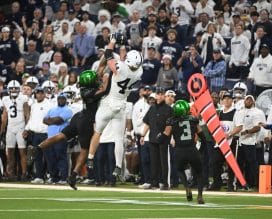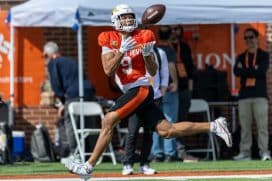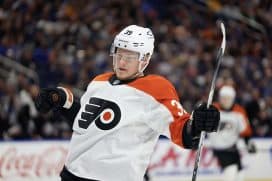Phillies
Satchel Paige Almost Played for the Phillies?
By Matt Albertson, Historical Columnist
Over the past few months, Tim Kelly, myself, and other Sports Talk Philly staff have presented our Top 25 Players to Ever Play a Game for the Phillies breakdown. Lists are fun because they create arguments and mean absolutely nothing in the grand scheme of the game and its history. Nevertheless, we presented a few qualitative and quantitative arguments as to why each player was ranked where they were on our list. Last year, I reviewed a few players who missed the Top 25 list. This year, I'm going to go a different route, along the lines of the infamous Sandlot line, "heroes get remembered, but legends never die." Except nobody remembers that baseball legend Satchel Paige almost played for the Phillies.
Stories surrounding Paige often seem emerge from the cloud of a rosy Hollywood fantasy, like the time he intentionally walked the bases loaded in the 1942 Negro League World Series for a do-or-die showdown with Josh Gibson, known as the black Babe Ruth. Paige told his teammates to sit down on the field and struck Gibson out swinging, ending the inning. Heck, Paige's birth date is even a fluid mystery.
Paige, the most prominent personality of the Negro Leagues, finally made it to the major leagues in 1948 at the assumed age of 41. He was signed by Cleveland Indians owner Bill Veeck, himself one of the most colorful characters in baseball's past. The Indians won the World Series that year, while Paige contributed a 6-1 record with a 2.48 ERA and made his lone World Series appearance in Game 5.
In 1951, Veeck purchased the putrid St. Louis Browns and sought to win back fans and create a winning culture. Veeck did whatever he could to bring people to the ballpark, such as signing 3' 7" Eddie Gaedel to a contract. In what was his only professional baseball appearance, Gaedel walked (the strike zone was 1.5" tall). Also, he orchestrated a hilarious promotion known as "Grandstand Managers Night," which allowed fans behind home plate to vote on key managerial in-game decisions using placards that read "yes" or "no." His promotions also included signing Paige, who pitched for the Browns from 1951-1953. Veeck sold the club in 1953 and new ownership moved the club to Baltimore. Ultimately, Paige was released. But the two crossed paths again, at Veeck's insistence, in 1955.
Veeck had been out of baseball since he sold the Browns in 1953, but the urge to return to the game proved too much and in 1955, he and his partners purchased the Syracuse Chiefs, the Phillies' Triple-A International League affiliate, and moved the club to Miami and christened them the Miami Marlins. Veeck biographer Paul Dickson wrote that "the group bought the team on the premise that they could make a lot more money in this new market, but their ultimate goal was to get Miami into the major leagues…[his partners] persuaded Veeck to come east and help upgrade Miami to major-league status, giving him the title of vice president." Veeck's first priority was to lease a stadium. Once completed, his next priority was to sign a high profile talent – Satchel Paige. Miami News columnist Norris Anderson explained the plan in the December 10, 1955 issue.
"Now it can be told. Only William (Barnum) Veeck, dealer in the colossal and the stupendous, could have foaled the idea. Here's what: Satchel Paige, the ageless pitching expertise of historic familiarity, was Veeck's choice to pitch the opening game at Miami Stadium if Miami got in the International League! Ol' Satch returning to organized baseball, thus would have become the most publicized opening day pitcher since a fella named Eisenhower began serving 'em up for the Senators."
The signing was kept secret from the public and reporters. But on April 18, 1956 Veeck surprised the few who attended the Marlins opener when Paige arrived on the field in a helicopter, amid a cloud of infield dust. In fact, the stunt nearly backfired, Marlins business manager Joe Ryan noted later. "We lost contact with the tower and we missed our cues…we were running out of fuel." Paige recalled "I was so scared…that pilot and me was like husband and wife until we landed." The stadium announcer introduced the legend when he walked out of the helicopter. "Welcome to our newest Marlin, Satchel Paige. The 8,000 fans in attendance roared with approval.
Paige was approximately 48 years old when the stunt took place and manager Don Osborn figured the stunt was a one-time publicity score. Osborn didn't want to use Paige as a regular pitcher during the season. Veeck had other thoughts and made Osborn a deal he couldn't refuse. Osborn chose his nine best hitters and Veeck agreed to pay $10 to any player who got a hit off of Paige. Nobody got a hit and Osborn put Paige on the regular roster.
In his first game with the Marlins, Paige threw a complete game four-hit shutout. By August, Paige had a 10-2 record with a 1.50 ERA and completed the season with an 11-4 record and a 1.86 ERA in 111 innings pitched. He pitched two more seasons for the Marlins and finished his time with the Phillies' highest minor league affiliate with a 31-22 record and a 2.48 ERA in 367 innings pitched – incredible numbers for a player of any age. The young players enjoyed having a legend on the team. In 1957, he was selected as the club's Most Valuable Player. In fact, one of Paige's teammates in Miami in 1957 and 1958 was beloved Phillies manager Dallas Green. On August 5, 1958 Marlins manager Joe Ryan informed the press that Paige left the club and was off the payroll. The aging legend accused the Marlins of not paying him his salary.
Veeck never got the Marlins into the major leagues and the Phillies transferred their Triple-A affiliate to Buffalo in 1959, while the Marlins became the Baltimore Orioles' affiliate.
Why wasn't Paige promoted, despite proving he had the talent? Veeck and Paige were essentially a package deal. Veeck needed a draw initially to get people interested in the team and to keep the dream of Miami in the major leagues alive. Of course, it never happened and both Veeck and Paige moved on to new ventures. The Philadelphia Inquirer mentioned on a few occasions between 1956 and 1958 that Paige was, despite his age, still an exceptional talent but never made mention of a promotion nor posit that the club should promote him. I can't say for certain that a promotion was never granted due to the Phillies aversion to having black players on the big league roster. Aside from his unique relationship with Veeck and therefore the Marlins, it's entirely plausible that a promotion just wasn't in the cards. It's also possible that the organization was wary of promoting a player in his late 40's, fearing ridicule of promoting such an old player while the team was in or near the National League cellar. After all, Veeck ran the Miami Marlins, not the Philadelphia Phillies, and he proved to be one of the very few men in the game willing to take chances on something strange, ridicule be damned. At least, I've not found anything in newspapers or secondary source material to suggest that a promotion was considered.
Paige's career continued on-and-off and included a few appearances in the major leagues again, with the Oakland Athletics, in 1965. He was elected into the Hall of Fame with several other Negro League legends in 1971. The Phillies finally integrated the major league roster when John Kennedy played a handful of games for the club in 1957. The Phillies didn't have a bonafide black superstar until Dick Allen arrived on the scene in 1964.





